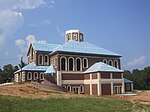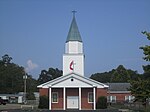Sibley, Louisiana
Sibley, Louisiana | |
|---|---|
Town | |
 Sibley Town Hall at site of former Sibley High School | |
 Location of Sibley in Webster Parish, Louisiana. | |
 Location of Louisiana in the United States | |
| Coordinates: 32°32′27″N 93°17′36″W / 32.54083°N 93.29333°W | |
| Country | United States |
| State | Louisiana |
| Parish | Webster |
| Government | |
| • Mayor | Jimmy Williams (No Party) (reelected 2016) Police Chief Jeremy Allen Robinson (No Party) (elected 2012) |
| Area | |
• Total | 4.00 sq mi (10.35 km2) |
| • Land | 3.89 sq mi (10.06 km2) |
| • Water | 0.11 sq mi (0.29 km2) |
| Elevation | 200 ft (60 m) |
| Population (2020) | |
• Total | 1,127 |
| • Density | 290.02/sq mi (111.98/km2) |
| Time zone | UTC-6 (CST) |
| • Summer (DST) | UTC-5 (CDT) |
| ZIP code | 71073 |
| Area code | 318 |
| FIPS code | 22-70175 |
| Website | www |
Sibley is a town in south Webster Parish, Louisiana, United States. The population was 1,218 at the 2010 census. It is part of the Minden Micropolitan Statistical Area.
The former Sibley High School, now known as Lakeside Junior/Senior High School, is located south of town off Louisiana Highway 7. The Sibley Town Hall was relocated to a portion of the former Sibley High School campus.






In a predominantly African American section of the nearby unincorporated community of Yellow Pine is an area formerly known as "King Solomon Hill," centered on an actual hill on which stood King Solomon Hill Baptist Church. (The community is now known as "Salt Works.") The blues historian Gayle Dean Wardlow concluded that it was from this address that Paramount Records chose to give the blues musician Joe Holmes, a resident of Sibley, the recording name of King Solomon Hill.[4]
Geography
Sibley is located at 32°32′27″N 93°17′36″W / 32.54083°N 93.29333°W (32.540704, -93.293208).[5]
According to the United States Census Bureau, the town has a total area of 4.0 square miles (10.4 km2), of which 3.9 square miles (10.0 km2) is land and 0.1 square mile (0.4 km2) (3.49%) is water.
Demographics
| Census | Pop. | Note | %± |
|---|---|---|---|
| 1920 | 900 | — | |
| 1930 | 422 | −53.1% | |
| 1940 | 405 | −4.0% | |
| 1950 | 623 | 53.8% | |
| 1960 | 595 | −4.5% | |
| 1970 | 869 | 46.1% | |
| 1980 | 1,211 | 39.4% | |
| 1990 | 997 | −17.7% | |
| 2000 | 1,098 | 10.1% | |
| 2010 | 1,218 | 10.9% | |
| 2020 | 1,127 | −7.5% | |
| U.S. Decennial Census[6][failed verification] | |||
| Race | Number | Percentage |
|---|---|---|
| White (non-Hispanic) | 816 | 72.4% |
| Black or African American (non-Hispanic) | 237 | 21.03% |
| Native American | 10 | 0.89% |
| Asian | 3 | 0.27% |
| Other/Mixed | 20 | 1.77% |
| Hispanic or Latino | 41 | 3.64% |
As of the 2020 United States census, there were 1,127 people, 554 households, and 396 families residing in the town.
Notable people
- Provine Bradley (1907-1986), Negro league baseball player
References
- ^ "2020 U.S. Gazetteer Files". United States Census Bureau. Retrieved March 20, 2022.
- ^ "Sibley Baptist Church celebrates 50th year", Minden Press-Herald, February 24, 1972, p. 1
- ^ "Sibley First Baptist grows from 14 members", Minden Press-Herald, July 31, 1987, p. 2C
- ^ Wardlow, Gayle Dean. Chasin' That Devil Music, Searching for the Blues. 1998. Miller Freeman Books. ISBN 0-87930-552-5. p. 211. Originally published as One Last Walk up King Solomon Hill in Blues Unlimited No. 148 (Winter 1987).
- ^ "US Gazetteer files: 2010, 2000, and 1990". United States Census Bureau. February 12, 2011. Retrieved April 23, 2011.
- ^ "Census of Population and Housing". United States Census Bureau. Retrieved June 4, 2015.
- ^ "Explore Census Data". data.census.gov. Retrieved December 29, 2021.
